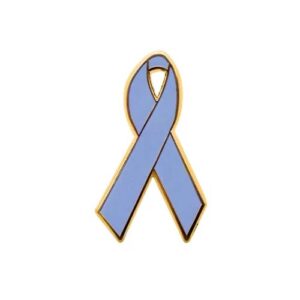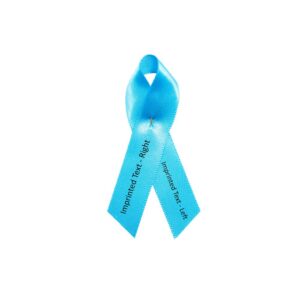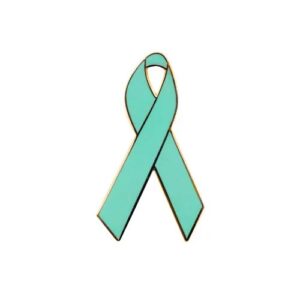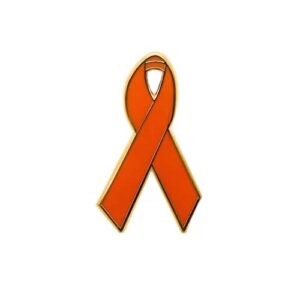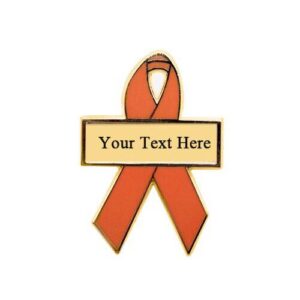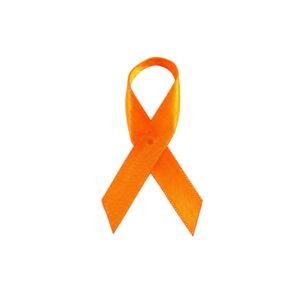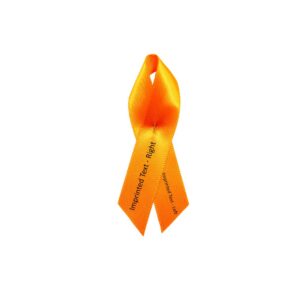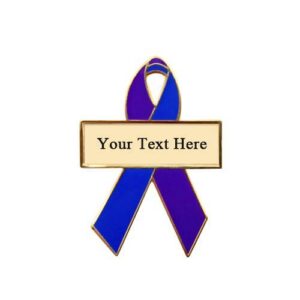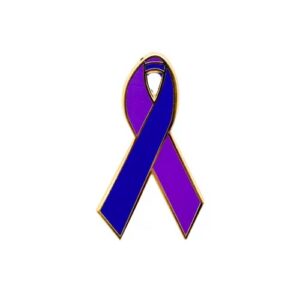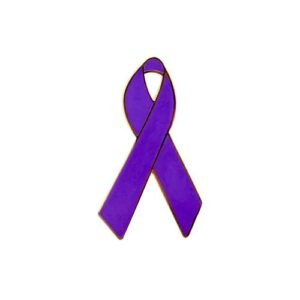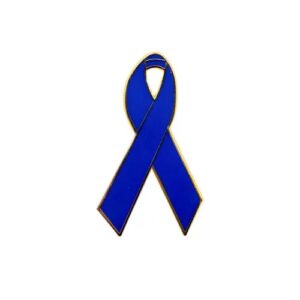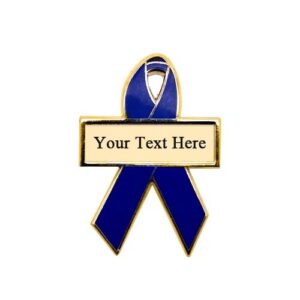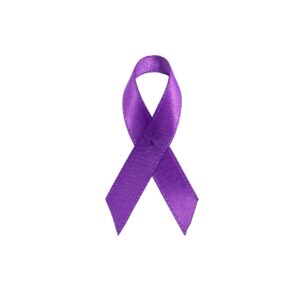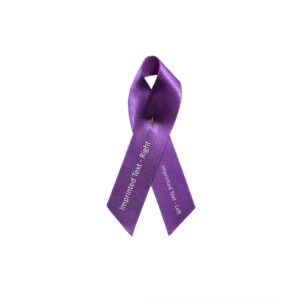Search by Color or Cause

Autoimmune disease awareness ribbons call attention to the more than eighty autoimmune diseases known at the present time. Because diagnosis is often difficult, being aware of signs and symptoms is key to effective treatment. Therefore, our comprehensive list gives insight into the many forms autoimmune diseases take.
An explanation of autoimmune diseases: A healthy immune system defends the body against disease and infection. When the immune system malfunctions, it attacks healthy cells, tissues, and organs. Called autoimmune disease, these attacks affect any part of the body, weakening bodily function and even becoming life-threatening. Autoimmune diseases can occur at any time throughout a person's life, ranging from childhood to later years.
Scientists recognize more than eighty autoimmune diseases. Well known autoimmune diseases are Type 1 Diabetes, Multiple Sclerosis (MS), Lupus, and Rheumatoid Arthritis (RA). Other autoimmune diseases are less common. Many conditions are rare and difficult to diagnose. Patients, therefore, may suffer for many years before getting a proper diagnosis. This is more common with unusual autoimmune diseases because many autoimmune diseases mimic other illnesses.
Most autoimmune diseases have no cure. Some, however, require lifelong treatment to ease symptoms. Others may have no treatment available at all. Only recently have scientists and pharmaceutical companies developed medications to treat autoimmune diseases. For example, many drugs are now available to treat autoimmune conditions such as psoriatic arthritis.
Previously, for diseases such as lupus, new medications were slow to come to market. For example, a new lupus drug had not been developed for fifty years. Now, there are alternatives to steroids and more toxic drugs. These new drugs, though, have their own set of complications.
The same is true for many other drugs that treat autoimmune diseases. That is why funding and research are so important. Funding and research are a direct result of awareness about autoimmune diseases. The more attention called to them, the more solutions become available to treat the conditions.
Light Blue Awareness or Light Green Awareness Ribbons for Achalasia Awareness
Achalasia is a rare disorder of the esophagus, the tube that carries food from the throat to the stomach. Symptoms include impaired ability to push food down toward the stomach. For this reason, eating and getting correct nutrition is difficult. Achalasia is a lifelong condition that may have serious symptoms. With proper treatment, symptoms can be managed so they do not disrupt everyday life.
Black and White Awareness Ribbons for Acute Disseminated Encephalomyelitis Awareness
Acute disseminated encephalomyelitis (ADEM) is a rare autoimmune disease that causes inflammation of the brain and spinal cord. It is characterized by a sudden, widespread attack on the myelin, the protective coating around nerves. ADEM is often triggered by a viral infection, such as a cold, but can also be caused by a bacterial infection or vaccination.
Purple and Blue Awareness Ribbons for Acute Motor Axonal Neuropathy Awareness
Acute motor axonal neuropathy (AMAN) is a variant of Guillain-Barre syndrome characterized by a rapid onset of muscle weakness and paralysis primarily affecting motor nerves. There is little to no sensory loss and is often caused by an immune response. The immune response is triggered by a preceding infection and diagnosed by the presence of damaged motor axons on nerve conduction studies. It is treated with therapies like plasmapheresis or intravenous immunoglobulin.
Light Blue Awareness Ribbons for Addison's Disease Awareness
Addison's disease, also called adrenal insufficiency, is an uncommon illness that occurs when the body doesn't make enough of certain hormones. In Addison's disease, the adrenal glands make too little cortisol and, often, too little of another hormone, aldosterone. Addison's disease can affect anyone and can be life-threatening. Treatment involves taking hormones to replace those that are missing.
Yellow and Blue Awareness Ribbons for Adiposis Dolorosa / Dercum's Disease Awareness
AAdiposis dolorosa is a condition characterized by painful folds of fatty (adipose) tissue or the growth of multiple noncancerous (benign) fatty tumors called lipomas. This condition occurs most often in women who are overweight or have obesity. Signs and symptoms typically appear between ages 35 and 50.
Red Awareness Ribbons for Adult-Onset Still's Disease Awareness
Adult-Onset Still's Disease is a rare inflammatory disorder that affects the entire body. As a result, affected individuals may develop episodes of high, spiking fevers. In addition, they may develop a pink or salmon colored rash, joint pain, muscle pain, a sore throat and other symptoms associated with systemic inflammatory disease.
Zebra Awareness Ribbons for Agammaglobulinemia Awareness
Agammaglobulinemia is an inherited disorder in which a person has very low levels of protective immune system proteins called immunoglobulins. Immunoglobulins are a type of antibody. Low levels of these antibodies make people more likely to get infections. This is a rare disorder that mainly affects males. It is caused by a gene defect that blocks the growth of normal, mature immune cells called B lymphocytes.
Blue Awareness Ribbons for Alopecia Areata Awareness
Alopecia areata is a common autoimmune skin disease. Because of it, hair loss on the scalp, face and sometimes other areas of the body occurs. Alopecia areata is an autoimmune disease that causes patchy hair loss anywhere on the body, but it most commonly affects the hair on the skin that covers the head (scalp). “Alopecia” is a medical term for hair loss or baldness, and “areata” means that it occurs in small, random areas.
Burgundy Awareness Ribbons for Amyloidosis Awareness
Amyloidosis is a rare disease that occurs when a substance called amyloid builds up in organs. Amyloid is an abnormal protein that is produced in bone marrow and can be deposited in any tissue or organ. The most common is the kidney. Diseases such as tuberculosis, rheumatoid arthritis or periodic fever syndromes may result in production of the serum amyloid A protein.
Blue Awareness Ribbons for Ankylosing Spondylitis Awareness
Ankylosing Spondylitis is a form of arthritis that primarily affects the spine. It can, occasionally, affect other joints. In addition, it causes inflammation of the spinal joints that can lead to severe, chronic pain and discomfort.
Green Awareness Ribbons for Anti-GBM / Anti-TBM Nephritis Awareness
Anti-Glomerular Basement Membrane Disease is a disease that occurs as a result of injury to small blood vessels in the kidneys and/or lungs. Anti-GBM disease is a rare autoimmune disease. It was previously known as Goodpasture syndrome.
Red Awareness Ribbons for Anti-Neutrophil Cytoplasmic Anti-Body Associated Vasculitis Awareness
Anti-neutrophil cytoplasmic antibody-associated vasculitis is a group of diseases that cause destruction and inflammation of small vessels. Symptoms of vasculitis include fatigue, muscle pain, fever, cough, hemoptysis, abdominal pain, blood in urine or weakness, and numbness in hands or feet. Treatment for vasculitis includes steroids along with other medications that suppress the immune system.
Purple Awareness Ribbons for Anti-N-Methyl-D-Aspartate Receptor Encephalitis Awareness
The major role of the immune system is to recognize and get rid of infection. Sometimes, however, some components of the immune system, called antibodies, may instead react with proteins in the body. As a result, it causes an autoimmune disease. When this reaction is against proteins in the brain, it is called autoimmune encephalitis.
Burgundy Awareness Ribbons for Antiphospholipid Syndrome Awareness
Antiphospholipid syndrome is an autoimmune disorder. Antiphospholipid syndrome occurs when the body's immune system makes antibodies that attack phospholipids. Specifically, phospholipids are a type of fat found in all living cells, including blood cells and the lining of blood vessels.
Blue Awareness Ribbons for Antisynthetase Syndrome Awareness
Antisynthetase syndrome is a rare autoimmune condition that causes inflammation throughout the body, particularly in the muscles and lungs. It may also include Raynaud's phenomenon or Raynaud's syndrome.
Red and White Pinstripes Awareness Ribbons for Aplastic Anemia Awareness
Aplastic anemia is a blood disorder in which the body's bone marrow does not make enough new blood cells. Symptoms can include fatigue, weakness, dizziness, shortness of breath, easy bruising, or bleeding. Symptoms can develop quickly or slowly, and the disease can be mild or severe.
Zebra Awareness Ribbons for Autoimmune Angioedema Awareness
Acquired Angioedema due to deficiency of C1-inhibitor is a relatively infrequently occurring but serious disorder. As a result, it may cause severe, sometimes life-threatening episodes of angioedema.
Light Blue Awareness Ribbons or Turquoise Awareness Ribbons for Autoimmune Dysautonomia Awareness
Dysautonomia is an umbrella medical term utilized for a group of complex conditions that are caused by a dysfunction of the autonomic nervous system. Orthostatic intolerance, the inability to remain upright, is a hallmark of the various forms of dysautonomia.
Zebra Awareness Ribbons for Autoimmune Encephalomyelitis Awareness
Autoimmune Encephalomyelitis is a serious medical condition in which the immune system attacks the brain, impairing function.
Purple Awareness Ribbons for Autoimmune Enteropathy Awareness
Autoimmune Enteropathy is a rare disease of intractable diarrhea, atrophy of the small intestine, and the presence of autoantibodies.
Red Awareness Ribbons for Autoimmune Hemolytic Anemia Awareness
Autoimmune Hemolytic Anemia is a group of rare but serious blood disorders. They occur when the body destroys red blood cells more rapidly than it produces them.
Purple and Yellow Awareness Ribbons for Autoimmune Hepatitis Awareness
Autoimmune Hepatitis is a chronic disease in which the body’s immune system attacks the liver and causes inflammation and liver damage.
Purple Awareness Ribbons for Autoimmune Inner Ear Disease Awareness
Autoimmune Inner Ear Disease is a bilateral, rapidly progressive hearing loss over a period of weeks to months.
Purple Awareness Ribbons for Autoimmune Lymphoproliferative Syndrome Awareness
Autoimmune Lymphoproliferative Syndrome is a disorder in which the body cannot properly regulate the number of immune system cells, called lymphocytes. Accumulation of excess lymphocytes results in enlargement of the lymph nodes, liver, and spleen.
Red and Purple Awareness Ribbons for Autoimmune Myocarditis Awareness
Autoimmune Myocarditis is an autoimmune disease that affects the heart. In addition, autoimmune Myocarditis causes inflammation of the heart muscle.
Purple Awareness Ribbons for Autoimmune Neutropenia Awareness
Autoimmune Neutropenia causes the body to identify the neutrophils as enemies and makes antibody to destroy them.
Purple Awareness Ribbons for Autoimmune Oophoritis Awareness
Autoimmune Oophoritis is a rare cause of primary ovarian insufficiency. It occurs when the body's immune system mistakenly attacks the ovaries, causing inflammation, atrophy and fibrosis. These changes stop the ovaries from working normally.
Purple Awareness Ribbons for Autoimmune Orchitis Awareness
Autoimmune Orchitis is testis inflammation and the presence of specific antisperm antibodies.
Purple Awareness Ribbons for Autoimmune Pancreatitis Awareness
Autoimmune Pancreatitis is a form of chronic pancreatitis associated with autoimmune manifestations. The disease represents a systemic autoimmune condition that involves not only the pancreas but also a variety of other organs such as the bile duct, retroperitoneum, and lymph nodes.
Purple Awareness Ribbons for Autoimmune Polyendocrine Syndrome Awareness
Autoimmune Polyendocrine Syndromes are a group of rare diseases characterized by autoimmune activity against more than one endocrine organ, although non-endocrine organs can be affected.
Purple Awareness Ribbons for Autoimmune Polyendocrine Syndrome Type 2 Awareness
Autoimmune Polyglandular Syndrome Type 2 is an autoimmune disorder that affects many hormone-producing glands. Addison's disease accompanies autoimmune thyroid disease and/or type 1 diabetes.
Purple Awareness Ribbons for Autoimmune Polyendocrine Syndrome Type 3 Awareness
Autoimmune Polyglandular Syndrome Type 3 is an autoimmune condition that affects the body's endocrine glands. The syndrome, which typically affects women during middle age, results from failure of the glands to produce their hormones.
Peach Awareness Ribbons for Autoimmune Progesterone Dermatitis Awareness
Autoimmune Progesterone Dermatitis is an uncommon disease that causes the appearance of a cyclic rash that develops premenstrually. It is considered a hypersensitivity reaction to progesterone.
Purple Awareness Ribbons for Autoimmune Retinopathy Awareness
Autoimmune Retinopathy is a rare eye disorder in which autoantibodies damage the retina, causing progressive vision loss.
Purple Awareness Ribbons for Autoimmune Thrombocytopenic Purpura Awareness
Immune Thrombocytopenic Purpura is a syndrome in which a decreased number of circulating platelets (thrombocytopenia) manifests as a bleeding tendency, easy bruising (purpura), or leaking of blood from capillaries into skin and mucous membranes (petechiae).
Purple Awareness Ribbons for Autoimmune Urticaria Awareness
Autoimmune Urticaria causes the immune system to attack the normal tissues of the body, causing hives.
Purple Awareness Ribbons for Autoimmune Uveitis Awareness
Uveitis is a relatively uncommon condition characterized by inflammation within the eye. If undiagnosed or untreated, it can lead to vision loss. Uveitis can be divided into several types based on where in the eye the inflammation occurs, including anterior uveitis (the front part of the eye) and posterior uveitis (the back part of the eye). It can occur by itself, or in association with other illnesses, including infections and autoimmune diseases. In particular, it is associated with ankylosing spondylitis, juvenile idiopathic arthritis, psoriatic arthritis and vasculitis.
Purple Awareness Ribbons for Axonal and Neuronal Neuropathy Awareness
Anonal and neuronal neuropathy is a variant of Guillain-Barré syndrome, an autoimmune disease. It is acute paralysis and loss of reflexes without sensory loss. The acute motor axonal neuropathy (AMAN) form of the Guillain-Barre syndrome is a paralytic disorder of abrupt onset characterized pathologically by motor nerve fiber degeneration of variable severity and by sparing of sensory fibers. There is little demyelination or lymphocytic inflammation.
Orange Awareness Ribbons for Balo's Disease Awareness
Balo Disease is a rare and progressive variant of multiple sclerosis. It usually first appears in adulthood, but childhood cases have also been reported. While multiple sclerosis typically is a disease that waxes and wanes, Balo Disease is different in that it tends to be rapidly progressive. Symptoms may include headache, seizures, gradual paralysis, involuntary muscle spasms, and cognitive loss.
Light Blue Awareness Ribbons for Behcet's Disease Awareness
Behcet's cisease, also called Behcet's syndrome, is a rare disorder that causes blood vessel inflammation throughout the body. Behçet’s disease can create issues in the mouth and genital area, in the form of recurrent sores. This condition is mostly associated with inflammation of both the blood vessels and the eyes, though it often causes a lot of different issues throughout the body.
Silver Awareness Ribbons for Bickerstaff's Encephalitis Awareness
Bickerstaff brainstem encephalitis (BBE) is a rare, autoimmune disease of the peripheral and central nervous system (i.e., brainstem). BBE is considered a variant of other immune-mediated polyneuropathies, such as Guillain Barré syndrome (GBS) and Miller Fisher syndrome (MFS). BBE classically presents as an acute triad of ataxia, encephalopathy, and ophthalmoplegia, typically subsequent to infection.
Red Awareness Ribbons for Benign Mucosal Pemphigoid Awareness
Cicatricial Pemphigoid is a rare chronic autoimmune blistering disease. Cicatricial pemphigoid (also known as benign mucosal pemphigoid, mucous membrane pemphigoid, or benign mucous membrane pemphigoid) is a rare chronic autoimmune blistering disease characterized by erosive skin lesions of the mucous membranes and skin that results in scarring of at least some sites of involvement. The autoimmune reaction most commonly affects the mouth, causing lesions in the gums, but it can also affect areas of mucous membrane elsewhere in the body, such as the sinuses, genitals and anus.
Red Awareness Ribbons for Bullous Pemphigoid Awareness
Bullous Pemphigoid is a rare skin condition that causes large, fluid-filled blisters. The blisters often appear on the skin near creases, such as the upper thighs and armpits. Sometimes, people get a rash instead of blisters. The affected areas may be painful and are usually very itchy. Blisters or sores also might form in the mouth, but this is rare. Bullous pemphigoid occurs when the immune system attacks a layer of tissue in the skin. The reason for this immune system response is not well understood. In some people, the condition is brought on by certain medicines.
Zebra Awareness Ribbons for Castleman Disease Awareness
Castleman disease is a group of rare disorders that involves lymph nodes that get bigger, called enlarged lymph nodes, and a wide range of symptoms. The most common form of the disorder involves a single enlarged lymph node. This lymph node is usually in the chest or neck, but it can occur in other areas of the body as well.
Light Green Awareness Ribbons for Celiac Disease Awareness
Celiac disease is an illness caused by an immune reaction to eating gluten. Gluten is a protein found in foods containing wheat, barley or rye. If you have celiac disease, eating gluten triggers an immune response to the gluten protein in the small intestine. Over time, this reaction damages the small intestine's lining and prevents it from absorbing nutrients, a condition called malabsorption. The intestinal damage often causes symptoms such as diarrhea, fatigue, weight loss, bloating or anemia. It also can lead to serious complications if it is not managed or treated. In children, malabsorption can affect growth and development in addition to gastrointestinal symptoms.
Red Awareness Ribbons for Chagas Disease Awareness
Chagas disease is an infectious disease caused by a protozoan parasite (Trypanosoma cruzi). However, this condition is the result of a complex health problem typical of neglected tropical diseases and socially determined diseases. A missed or late diagnosis with absent or incomplete treatment and follow-up can transform this infection into a life-threatening condition.
Blue Awareness Ribbons for Chronic Fatigue Syndrome Awareness
Myalgic encephalomyelitis/chronic fatigue syndrome (ME/CFS) is a complicated disorder. It causes extreme fatigue that lasts for at least six months. Symptoms worsen with physical or mental activity but don't fully improve with rest. The cause of ME/CFS is unknown, although there are many theories. Experts believe it might be triggered by a combination of factors. There's no single test to confirm a diagnosis. You may need a variety of medical tests to rule out other health problems that have similar symptoms. Treatment for the condition focuses on easing symptoms.
Blue Awareness Ribbons for Chronic Inflammatory Demyelinating Polyneuropathy Awareness
CIDP chronic inflammatory demyelinating polyneuropathy is an autoimmune condition that affects the myelin sheath around your peripheral nerves. This causes worsening symptoms, like muscle weakness and abnormal sensations, over at least eight weeks. CIDP is treatable, but it can come back (relapse), which may require ongoing treatment.
White Awareness Ribbons for Chronic Recurrent Multifocal Osteomyelitis Awareness
Chronic recurrent multifocal osteomyelitis (CRMO) is a non-infectious, inflammatory disorder of the bones. CRMO typically affects children, with a predisposition to females. Bone-related pain is often felt in the metaphysis of long bones, particularly of the lower extremities. It can also target other sites at varied time intervals. Patients are likely to complain of tenderness and swelling that may cause considerable disability and adversely impact quality of life.
Red Awareness Ribbons for Churg-Strauss Syndrome or Eosinophilic Granulomatosis Awareness
Eosinophilic granulomatosis with polyangiitis (EGPA) is a rare immune disorder involving your respiratory system. It was previously known as Churg-Strauss syndrome. EGPA affects people with a history of allergies or asthma. It causes inflammation in the blood vessels and small masses that infiltrate the tissues, especially in the lungs.
Purple Awareness Ribbons for Cicatricial Pemphigoid Awareness
Mucous membrane pemphigoid (MMP) is a group of rare chronic autoimmune disorders characterized by blistering lesions that primarily affect the various mucous membranes of the body. The mucous membranes of the mouth and eyes are most often affected. The mucous membranes of the nose, throat, genitalia, and anus may also be affected. The symptoms of MMP vary among affected individuals depending upon the specific site(s) involved and the progression of the disease. Blistering lesions eventually heal, sometimes with scarring. Progressive scarring may potentially lead to serious complications affecting the eyes and throat. In some cases, blistering lesions also form on the skin, especially in the head and neck area. The exact cause of MMP is unknown
Red Awareness Ribbons for Cogan's Syndrome Awareness
Cogan’s syndrome is a rare autoimmune disease that primarily affects the eyes and inner ears. It can also cause inflammation of the blood vessels (vasculitis). Cogan’s syndrome is a form of vasculitis. Vasculitis is a family of rare disorders characterized by inflammation of the blood vessels, which can restrict blood flow and damage vital organs and tissues. Cogan’s syndrome primarily affects the large vessels. It especially affects aorta, which carries oxygenated blood from the heart to the rest of the body.
Red Awareness Ribbons for Cold Agglutinin Disease Awareness
Orange Awareness Ribbons for Complex Regional Pain Syndrome Awareness
Complex regional pain syndrome is a form of chronic pain that usually affects an arm or a leg. CRPS typically develops after an injury, surgery, stroke or heart attack. The pain is out of proportion to the severity of the initial injury. There are several treatment options for CRPS. The sooner you receive a diagnosis and treatment, the more likely your symptoms will improve.
Red and Blue Awareness Ribbons for Congenital Heart Block Awareness
Congenital heart block is interference with the transfer of electrical nerve impulses that regulate the normal, rhythmic, pumping action of the heart muscle. Congenital heart block is a rare complication of pregnancy associated with Sjögren Syndrome (an autoimmune syndrome) that may result in the death of the fetus or infant, or the need for pacing in the newborn or at a later stage. Doctors might detect congenital heart block before or after a baby is born. Certain diseases that may occur during pregnancy can cause heart block in a baby. Heart block is a problem that occurs with the heart’s electrical system. This system controls the rate and rhythm of heartbeats.
Red Awareness Ribbons for Coxsackie Myocarditis Awareness
Coxsackie myocarditis is inflammation and weakness of the heart muscle caused by a viral infection (Coxsackie virus) that reaches the heart. Myocarditis can damage the heart muscle causing it to become thick and swollen. The heart muscle may be directly damaged by the virus or the bacteria that infect it. The body’s immune response can also damage the heart muscle (called the myocardium) in the process of fighting the infection. This can lead to symptoms of heart failure.
Teal Awareness Ribbons for CREST Syndrome Awareness
CREST Syndrome is an acronym for calcinosis, Raynaud’s phenomenon, esophageal dysfunction, sclerodactyly, and telangiectasia. CREST syndrome is a type of scleroderma. It’s sometimes called limited cutaneous scleroderma. Scleroderma refers to a number of conditions that cause an abnormal buildup of collagen in the body. Too much of this protein makes the skin and other connective tissues thicken and harden. In some cases, it can also affect the organs, such as the lungs and heart. CREST syndrome is an autoimmune disease. That means the immune system is not working the right way. It attacks itself. This rare health problem is more likely to happen in women. It often strikes people in their 30s to 50s.
Purple Awareness Ribbons for Crohn's Disease Awareness
Crohn’s Disease belongs to a group of conditions known as inflammatory bowel diseases, or IBS. Crohn’s Disease is a chronic inflammatory condition of the gastrointestinal tract. It is a type of inflammatory bowel disease (IBD) that causes the digestive tract to become swollen and irritated. If you have Crohn’s, you might experience symptoms like abdominal pain, diarrhea, weight loss and rectal bleeding. This is a lifelong condition that can’t be cured. However, treatments typically help manage your symptoms and allow sufferers to live an active life.
Light Green Awareness Ribbons for Dermatitis Herpetiformis Awareness
Dermatitis herpetiformis, also known as Duhring disease, is a rare autoimmune disease of the skin. It is characterized by an extremely itchy, inflamed, blistering rash that most commonly develops on the elbows, knees, buttocks, back, and scalp. The rash develops after gluten is consumed. Most people who have dermatitis herpetiformis also have celiac disease, an autoimmune disease that primarily affects the small intestine and, like dermatitis herpetiformis, is triggered by the consumption of gluten.
Blue Awareness Ribbons for Dermatomyositis Awareness
Dermatomyositis is an uncommon inflammatory disease marked by muscle weakness and a distinctive skin rash. Dermatomyositis is a rare disease and is a form of myopathy. It can also cause severe symptoms that affect your ability to breathe and swallow. Dermatomyositis is a form of polymyositis that affects your skin in addition to your muscles.
Blue Awareness Ribbons for Juvenile Dermatomyositis Awareness
Dermatomyositis is an uncommon inflammatory disease marked by muscle weakness and a distinctive skin rash. In children, it most often appears between 5 and 15 years of age. Juvenile dermatomyositis (JDM) is a disease in children that causes skin rash (dermato) and muscle inflammation (myositis). It results in weak muscles. JDM is a type of autoimmune disease. The immune system is a group of cells that protect the body from infections. In autoimmune diseases such as JDM, these cells fight the body's own tissues and cells. This causes inflammation and sometimes tissue damage.
Green Awareness Ribbons for Devic's Disease / Neuromyelitis Optica Awareness
Neuromyelitis optica (NMO) is a rare chronic condition that affects eyesight and the ability to move. It’s an autoimmune disorder, meaning it happens because the immune system mistakenly attacks parts of the central nervous system. This condition has undergone name changes over the years. The condition’s original name, Devic’s disease, comes from Eugène Devic, the French neurologist who first described it. However, an international group of experts gave the condition its current name in 2015. This condition’s full, formal name is neuromyelitis optica spectrum disorder (NMOSD). But it’s still common for healthcare providers and other experts to simply call it neuromyelitis optica.
Blood Drop Awareness Ribbons for Diabetes Mellitus Type 1 Awareness
Type 1 diabetes, once known as juvenile diabetes or insulin-dependent diabetes, is a chronic condition. In this condition, the pancreas makes little or no insulin. Insulin is a hormone the body uses to allow sugar (glucose) to enter cells to produce energy. Different factors, such as genetics and some viruses, may cause type 1 diabetes. Although type 1 diabetes usually appears during childhood or adolescence, it can develop in adults. Even after a lot of research, type 1 diabetes has no cure. Treatment is directed toward managing the amount of sugar in the blood using insulin, diet and lifestyle to prevent complications.
Purple Awareness Ribbons for Discoid Lupus Erythematosus Awareness
Discoid Lupus Erythematosus is a chronic skin condition of sores with inflammation and scarring, typically occurring on the face, ears, and scalp. Discoid lupus erythematosus (DLE) is a chronic scarring skin condition. It is the most common form of cutaneous lupus. DLE is a sub-type of chronic cutaneous lupus erythematosus. It is characterized by persistent scaly plaques on the scalp, face, and ears which subsequently can progress to scarring, atrophy, dyspigmentation, and permanent hair loss in affected hair-bearing areas.
Red Awareness Ribbons for Dressler's Syndrome Awareness
Dressler's Syndrome is inflammation of the sac surrounding the heart. Dressler's Syndrome is believed to be an immune system response from events such as a heart attack, surgery or traumatic injury.
Yellow Awareness Ribbons for Endometriosis Awareness
Endometriosis is an often-painful condition in which tissue that is similar to the inner lining of the uterus grows outside the uterus. It often affects the ovaries, fallopian tubes and the tissue lining the pelvis. Rarely, endometriosis growths may be found beyond the area where pelvic organs are located. Endometriosis tissue acts as the lining inside the uterus would. It thickens, breaks down and bleeds with each menstrual cycle. But it grows in places where it doesn't belong, and it doesn't leave the body. When endometriosis involves the ovaries, cysts called endometriomas may form. Surrounding tissue can become irritated and form scar tissue. Bands of fibrous tissue called adhesions also may form. These can cause pelvic tissues and organs to stick to each other.
Blue Awareness Ribbons for Enthesitis Awareness
Enthesopathy is a broad term for any health condition or injury that affects the places tendons and ligaments connect to bones throughout your body. Tendons and ligaments are both strong, flexible bands of tissue. Tendons connect muscles to bones. Ligaments connect bones to bones. An enthesis is the medical name for the exact location on a bone where a tendon or ligament connects. The suffix “-pathy” at the end of a word means a disorder or issue that affects that body part. So, enthesopathy is something wrong with one or more of your entheses and that connective tissue.
Blue Awareness Ribbons for Enthesitis-Related Arthritis Awareness
There are many different types of arthritis. Enthesitis-Related Arthritis is one type. Enthesitis is swelling or inflammation of the entheses, the connective tissue where tendons or ligaments attach to bone.
Fuchsia Awareness Ribbons for Eosinophilic Esophagitis Awareness
Eosinophilic esophagitis is inflammation in the esophagus, the tube that connects the mouth and stomach. In this disease, white blood cells (eosinophils) collect in the esophagus and cause inflammation. Without treatment, this inflammation can lead to scar tissue and narrowing in the esophagus, causing difficulty swallowing. Sufferers may feel like something is stuck or moving slowly through the esophagus.
Red Awareness Ribbons for Epidermolysis Bullosa Acquisita Awareness
Epidermolysis bullosa acquisita (EBA) is a rare autoimmune blistering disease in which tense subepithelial blisters appear at sites of trauma. Unlike EB, EBA is not inherited and usually presents in adult life. EBA blisters tend to be localized to areas that are easily injured such as the hands, feet, knees, elbows, and buttocks. Sometimes there is mucosal involvement with blisters forming in the mouth, nose and eyes. Mucosal is an adjective pertaining to mucosa(e), the moist mucous membranes that line all body cavities and passages that are exposed to the external environment.
Purple Awareness Ribbons for Erythema Nodosm Awareness
Erythema nodosum is a type of skin inflammation that results in reddish, painful, tender lumps most commonly located in the front of the legs below the knees. Erythema nodosum is a type of panniculitis, an inflammatory disorder affecting subcutaneous fat. It presents as tender red nodules on the anterior shins. Less commonly, they affect the thighs and forearms. Erythema nodosum is a hypersensitivity reaction of unknown cause in up to 55% of patients. In other cases, it is associated with an identified infection, drug, inflammatory condition, or malignancy.
Red Awareness Ribbons for Essential Mixed Cryoglobulinemia Awareness
Essential mixed cryoglobulinemia is often found in people who have a chronic (long-lasting) inflammatory condition, such as an autoimmune disease or hepatitis C. Most people with mixed cryoglobulinemia have a chronic hepatitis C infection. Cryoglobulins are antibodies. It is not yet known why they become solid or gel-like at low temperatures. When this occurs, these antibodies can block blood vessels. This may lead to problems ranging from skin rashes to kidney failure. Cryoglobulinemia is the presence of these abnormal proteins in the blood.
Red Awareness Ribbons for Evans Syndrome Awareness
Evans syndrome is a rare autoimmune disorder where a child’s immune system mistakenly attacks their body. Most commonly, it affects the numbers of red blood cells (affecting the amount of oxygen that travels through blood and to the tissues) and the platelets (the part of the blood that helps to stop bleeding and heal wounds). It can also affects the body’s first line of defense against illness by destroying white blood cells that help fight bacterial infection (the neutrophils).
Purple and Blue Awareness Ribbons for Felty Syndrome Awareness
Felty syndrome is a triad of three conditions that occur together:
It usually starts with rheumatoid arthritis (RA), and the other two conditions occur as complications of RA. Healthcare providers call these “extra-articular manifestations,” meaning they’re manifestations of arthritis that occur outside of the joints. The same inflammatory and autoimmune processes cause them. Extra-articular manifestations are common with RA, but Felty syndrome is relatively rare.
Purple Awareness Ribbons for Fibromyalgia Awareness
Fibromyalgia is a disorder of widespread musculoskeletal pain accompanied by fatigue, sleep, memory and mood issues. Fibromyalgia is a chronic (long-lasting) disorder. Scientists do not fully understand what causes it, but people with the disorder have an increased sensitivity to pain. There is no cure for fibromyalgia, but doctors and other health care providers can help manage and treat the symptoms. Treatment typically involves a combination of exercise or other movement therapies, psychological and behavioral therapy, and medications.
Red and Blue Awareness Ribbons for Fibrosing Alveolitis Awareness
Fibrosing alveolitis, also known as Idiopathic pulmonary fibrosis (IPF), involves scarring or thickening of the lungs. Doctors do not know what causes idiopathic pulmonary fibrosis (IPF) or why some people get it. Idiopathic means the cause is not known. The condition may be due to the lungs and autoimmune system responding to an unknown substance or injury. Genes may play a role in developing IPF. The disease occurs most often in people between 50 and 70 years old.
Yellow Awareness Ribbons for Gastritis Awareness
Gastritis is an inflammation, irritation, or erosion of the lining of the stomach. It can occur suddenly or gradually. The lining (a soft tissue called mucosa) protects the stomach from the acids, enzymes and microorganisms that pass through it every day. Gastritis happens when the immune system detects a threat to this barrier. The immune system triggers inflammation in the tissues to help fight infections and promote healing.
Fuchsia Awareness Ribbons for Gestational Pemphigoid Awareness
Pemphigoid gestationis is an autoimmune disease, which means a woman’s immune system is attacking a normal component of her own skin. In pemphigoid gestationis, PG factor, a specific immunoglobulin type G (IgG) in the blood, binds to the BP-180 protein located in the basement membrane of the skin leading to tissue damage and blistering. The usual function of BP-180 is to help stick the epidermis and dermis together, so the blister split is in the basement membrane.
Red Awareness Ribbons for Giant Cell Arteritis / Temporal Arteritis Awareness
Giant Cell Arteritis, or Temporal Arteritis, is an inflammatory disease affecting the large blood vessels of the scalp, neck and arms. Inflammation causes a narrowing or blockage of the blood vessels, which interrupts blood flow.
Red Awareness Ribbons for Giant Cell Myocarditis Awareness
Giant cell myocarditis (GCM) is a rapidly progressive and frequently fatal disease that mainly affects young to middle-aged previously healthy individuals. Early diagnosis is critical, as recent studies have shown that rapidly instituted cyclosporine-based immunosuppression can reduce inflammation and improve transplant-free survival. Before the 1980s, GCM was mainly a diagnosis made at autopsy.
Green Awareness Ribbons for Glomerulonephritis Awareness
Glomerulonephriti is inflammation of the tiny filters in the kidneys (glomeruli). The excess fluid and waste that glomeruli remove from the bloodstream exit the body as urine. Glomerulonephritis can come on suddenly (acute) or gradually (chronic). Glomerulonephritis occurs on its own or as part of another disease, such as lupus or diabetes. Severe or prolonged inflammation associated with glomerulonephritis can damage the kidneys. Treatment depends on the type of glomerulonephritis a person has.
Green Awareness Ribbons for Goodpasture Syndrome Awareness
Goodpasture syndrome is a potentially life-threatening autoimmune disorder. It causes the immune system to attack tissues in the lungs and kidneys. Symptoms include trouble breathing and coughing up blood. Without treatment, it can lead to lung damage, kidney failure and death. Treatment includes medications and a type of blood transfusion.
Red Awareness Ribbons for Granulomatosis with Polyangiitis Awareness
Granulomatosis with polyangiitis is an uncommon disorder that causes inflammation of the blood vessels in your nose, sinuses, throat, lungs and kidneys. Formerly called Wegener's granulomatosis, this condition is one of a group of blood vessel disorders called vasculitis. It slows blood flow to some of the organs. The affected tissues can develop areas of inflammation called granulomas, which can affect how these organs work. Early diagnosis and treatment of granulomatosis with polyangiitis might lead to a full recovery. Without treatment, the condition can be fatal.
Light Blue Awareness Ribbons Or Paisley Awareness Ribbons for Graves' Disease Awareness
Graves’ disease is an autoimmune disease that affects the thyroid gland. The gland produces too much thyroid hormone, a condition known as hyperthyroidism. Thyroid hormones regulate body temperature, heart rate and metabolism. An overactive thyroid causes problems with organs like the heart, as well as bones and muscles. Treatments can help.
Teal Awareness Ribbons for Graves' Ophthalmopathy Awareness
Graves’ Eye Disease, also called Graves’ Ophthalmopathy or Thyroid Eye Disease, is a problem that usually develops in people with an overactive thyroid caused by Graves’ Disease.
Blue Awareness Ribbons for Guillain-Barre Syndrome Awareness
Guillain-Barre syndrome is a condition in which the body's immune system attacks the nerves. It can cause weakness, numbness or paralysis. Weakness and tingling in the hands and feet are usually the first symptoms. These sensations can quickly spread and may lead to paralysis. In its most serious form, Guillain-Barre syndrome is a medical emergency. Most people with the condition need treatment in a hospital. Guillain-Barre syndrome is rare, and the exact cause is not known. But two-thirds of people have symptoms of an infection in the six weeks before Guillain-Barre symptoms begin. Infections can include a respiratory or a gastrointestinal infection, including COVID-19. Guillain-Barre also can be caused by the Zika virus.
Zebra Awareness Ribbon for Hashimoto's Encephalopathy Awareness
Hashimoto’s encephalopathy (HE) is a rare condition, which is probably of autoimmune origin. Autoimmunity describes disorders in which the immune system mistakenly attacks the body’s own cells. HE can affect all age groups but typically affects females of around 50 years of age. Recent insights into other forms of autoimmune encephalitis have taught us that HE may not represent a single diagnosis, but a syndrome which includes a number of specific conditions. Therefore, the symptoms and signs of HE are varied.
Paisley Awareness Ribbon for Hashimoto's Thyroiditis Awareness
Hashimoto’s disease, also known as Hashimoto’s thyroiditis, is a thyroid autoimmune disorder often triggered by genetic or environmental factors. Immune cells in the body mistakenly produce antibodies to attack and destroy healthy, hormone-producing thyroid cells. As a result, those with Hashimoto’s often experience hypothyroidism, a condition in which the thyroid does not create and release enough thyroid hormone into the bloodstream.
Red Awareness Ribbons for Hemolytic Anemia Awareness
Hemolytic anemia is a blood disorder that typically happens when red blood cells break down or die faster than the body can replace them with new blood cells. People may develop hemolytic anemia by inheriting genetic conditions that cause anemia, certain infections and certain medications. Healthcare providers treat this condition by treating the underlying issue.
Purple Awareness Ribbons for Henoch-Schonlein Purpura Awareness
Henoch-Schonlein purpura (also known as IgA vasculitis) is a disorder that causes the small blood vessels in the skin, joints, intestines and kidneys to become inflamed and bleed. Henoch-Schonlein purpura is an inflammation of the small blood vessels of the skin, joints, bowels and kidneys. When blood vessels get inflamed, they can bleed into the skin, causing a reddish-purple rash (purpura). The most striking feature of this form of vasculitis is a purplish rash, typically on the lower legs and buttocks. Henoch-Schonlein purpura can also cause abdominal pain and aching joints. Rarely, serious kidney damage can occur.
Fuchsia Awareness Ribbons for Herpes Gestationis / Pemphigoid Gestationis Awareness
Herpes gestationis or pemphigoid gestationis (PG) is a bullous (characterized by blistering, such as a second-degree burn) disease developing in association with pregnancy. It is believed to be an autoimmune disorder. It occurs during pregnancy, typically in the second or third trimester, and/or immediately following pregnancy. It was originally called herpes gestationis because of the blistering appearance, although it is not associated with the herpes virus. Diagnosis of PG becomes clear when skin lesions progress to tense blisters during the second or third trimester.
Purple and Blue Awareness Ribbons for Hidradenitis Suppurativa Awareness
Hidradenitis suppurativa (HS) is a chronic inflammatory condition that causes painful bumps under the skin in the hair roots and near sweat glands. It’s also known as acne inversa. The bumps can get infected. When that happens, pockets form under the skin and fill with pus. They can smell bad when they break open. They can also leave scars.
Zebra Awareness Ribbons for Hypogammalobulinemia Awareness
Hypogammaglobulinemia is a problem with the immune system that prevents it from making enough antibodies called immunoglobulins. Antibodies are proteins that help the body recognize and fight off foreign invaders like bacteria, viruses, and fungi. Without enough antibodies, people are more likely to get infections. Those with hypogammaglobulinemia can more easily catch pneumonia, meningitis, and other infections that a healthy immune system would normally protect against. These infections can damage organs and lead to potentially serious complications.
Orange Awareness Ribbons for Idiopathic Inflammatory Demyelinating Diseases Awareness
A demyelinating disease affects the myelin sheath. This is a protective cover that surrounds nerve cells. Damage to the myelin can happen if the immune system mistakes healthy nerve cells for harmful ones. The most common demyelinating disease is multiple sclerosis. Treatment varies based on what type of demyelinating disease affects a person.
Green Awareness Ribbons for IgA Nephropathy Awareness
IgA nephropathy, also known as Berger disease, is a kidney disease. It happens when a germ-fighting protein called immunoglobulin A (IgA) builds up in the kidneys. This causes a type of swelling called inflammation that, over time, can make it harder for the kidneys to filter waste from the blood.
Purple Awareness Ribbons for IgG4-Related Sclerosing Disease Awareness
IgG4-related sclerosing disease, also known as IgG4–related systemic disease (IgG4-RSD), hyper-IgG4 disease and IgG4-related disease is an autoimmune disease in which inflammatory cells cause fibrosis, the deposition of connective tissue, in one or more organs. The disease is so named because the antibody subtype IgG4 can be detected on tissue samples and often at elevated levels in the bloodstream. The association with IgG4 is a relatively recent finding, and the condition has been described under numerous other names in the past.
Purple Awareness Ribbons for Immune Thrombocytopenic Purpura Awareness
Immune thrombocytopenia (ITP) is a form of low platelet count, a condition that keeps blood from clotting. When the blood can’t make clots, a person may bruise easily, bleed a lot when they’re hurt or start bleeding for no reason. Immune thrombocytopenia happens when the immune system clears platelets from circulation and the platelet level goes down. In some cases, ITP goes away on its own or with treatment. Other times, immune thrombocytopenia is a chronic condition, which means symptoms can be treated, but not cured. People with chronic ITP may need treatment for the rest of their lives.
Blue Awareness Ribbons for Inclusion Body Myositis Awareness
Inclusion body myositis is a rare condition that causes muscle weakness and damage. Symptoms of IBM vary, but usually include progressive weakness in muscles of the hand, forearm, thigh and lower leg. Diagnosing IBM can be challenging because the symptoms are not unique to this condition.
Purple Awareness Ribbons for Inflammatory Bowel Disease Awareness
Inflammatory bowel disease (IBD) is a term that describes disorders involving long-standing (chronic) inflammation of tissues in the digestive tract. Types of IBD include ulcerative colitis and Crohn's disease. Ulcerative colitis involves inflammation and sores (ulcers) along the lining of the large intestine (colon) and rectum. Crohn's disease is characterized by inflammation of the lining of the digestive tract, which often can involve the deeper layers of the digestive tract. Crohn's disease most commonly affects the small intestine. However, it can also affect the large intestine and uncommonly, the upper gastrointestinal tract. Both ulcerative colitis and Crohn's disease usually are characterized by diarrhea, rectal bleeding, abdominal pain, fatigue and weight loss.
Purple Awareness Ribbons for Intermediate Uveitis Awareness
Intermediate uveitis is an intraocular inflammation involving the anterior vitreous, peripheral retina and pars plana. It usually affects patients from 5 to 30 years old, without gender or racial preferences. The etiology is unknown but there are several associated diseases: multiple sclerosis, idiopathic optic neuritis, autoimmune corneal endotheliopathy, sarcoidosis, thyroid diseases and inflammatory bowel diseases. Symptoms are blurry vision, floaters and distortion of central vision.
Teal Awareness Ribbons for Interstitial Cystitis Awareness
Interstitial cystitis (IC)/bladder pain syndrome (BPS) is a chronic bladder health issue. It is a feeling of pain and pressure in the bladder area. Along with this pain are lower urinary tract symptoms which have lasted for more than 6 weeks, without having an infection or other clear causes.
Symptoms range from mild to severe. For some patients the symptoms may come and go, and for others they don't go away. IC/BPS is not an infection, but it may feel like a bladder infection. Women with IC/BPS may feel pain when having sex. Some people with IC/BPS have other health issues such as irritable bowel syndrome, fibromyalgia, and other pain syndromes.
Blue Awareness Ribbons for Juvenile Arthritis Awareness
Juvenile arthritis (JA), also known as pediatric rheumatic disease, isn’t a specific disease. It’s an umbrella term to describe the inflammatory and rheumatic diseases that develop in children under the age of 16. These conditions affect hundreds of thousands of kids and teens in the United States Most kinds of JA are autoimmune or auto-inflammatory diseases. That means the immune system, which is supposed to fight against foreign invaders like viruses and germs, instead releases inflammatory chemicals that attack healthy cells and tissue. In most JA cases this causes joint inflammation, swelling, pain and tenderness. Some types of JA have few or no joint symptoms or only affect the skin and internal organs. The exact causes of JA are unknown, but researchers believe that certain genes may cause JA when activated by a virus, bacteria or other external factors. There is no evidence that foods, toxins, allergies or lack of vitamins cause the disease.
Blood Drop Awareness Ribbons for Juvenile Diabetes / Type 1 Diabetes Awareness
Type 1 diabetes (juvenile diabetes) is an autoimmune disease that affects nearly 1.6 million people in the United States. An autoimmune disease is a condition where the body’s own immune cells turn “self-reactive” and mistakenly attack healthy tissue, triggering inflammation and cell death. In people with type 1 diabetes, self-reactive T cells kill beta cells in an organ called the pancreas, destroying the body’s ability to produce insulin. Without insulin, glucose cannot enter cells to produce energy. When people with type 1 diabetes experience a glucose build up in the blood, they can suffer from dehydration, weight loss, nerve and blood vessel damage, organ damage and life-threatening diabetic ketoacidosis.
Blue Awareness Ribbons for Juvenile Myositis Awareness
Juvenile myositis is a rare, childhood autoimmune disease that primarily causes inflammation in the muscles, skin and blood vessels. The inflammation leads to weakness in the muscles and rashes on the skin. The most common type of juvenile myositis is juvenile dermatomyositis, or JDM, which is characterized by specific rashes. There are other forms of juvenile myositis that are even more rare, such as polymyositis, which do not have characteristic rashes. Other autoimmune diseases can cause myositis, too.
Red Awareness Ribbons or Orange and Red Awareness Ribbons for Kawasaki Disease Awareness
Kawasaki disease, also known as Kawasaki syndrome or mucocutaneous lymph node syndrome, affects children and includes several symptoms. Symptoms may be fever, rash, swelling of the hands and feet, irritation and redness of the whites of the eyes, swollen lymph glands in the neck, and irritation and inflammation of the mouth, lips and throat.
Purple Awareness Ribbons for Lambert-Eaton Myasthenic Syndrome Awareness
Lambert-Eaton Myasthenic Syndrome is an autoimmune disease, a disease in which the immune system attacks the body's own tissues. The attack occurs at the connection between nerves and muscles and interferes with the ability of nerve cells to send signals to muscle cells.
Red Awareness Ribbons for Leukocytoclastic Vasculitis Awareness
Leukocytoclastic vasculitis is a cutaneous, small-vessel vasculitis of the dermal capillaries and venules. This condition can be idiopathic or can be associated with infections, neoplasms, autoimmune disorders, and drugs. Key clinical features of leukocytoclastic vasculitis include palpable purpura on the lower extremity, small vessel involvement, and, in about 30% of individuals, extracutaneous involvement. Most cases of idiopathic cutaneous, small vessel vasculitis are self-limited with 90% of cases resolving in weeks to months of onset.
Lavender and White Awareness Ribbons for Lichen Planus Awareness
Lichen planus is an inflammatory condition that can affect the skin, hair, nails and mucous membranes. On the skin, lichen planus usually appears as purplish, often itchy, flat-topped bumps, developing over several weeks. In the mouth, vagina and other areas covered by a mucous membrane, lichen planus forms lacy white patches, sometimes with painful sores.
Teal Awareness Ribbons for Lichen Sclerosus Awareness
Lichen sclerosus is an uncommon condition that creates patchy, white skin that appears thinner than normal. It usually affects the genital and anal areas. Anyone can get lichen sclerosus but postmenopausal women are at higher risk. It is not contagious and can't be spread through sexual contact. Treatment is usually a medicated ointment. This treatment helps return the skin to its usual color and reduces the risk of scarring. Even if symptoms clear up, they tend to come back.
Green Awareness Ribbons for Ligneous Conjunctivitis Awareness
Ligneous conjunctivitis is a rare disorder characterized by the buildup of a protein called fibrin which causes inflammation of the conjunctiva (conjunctivitis) and leads to thick, woody (ligneous), inflamed growths that are yellow, white, or red. Ligneous conjunctivitis most often occurs on the inside of the eyelids, but may also affect the sclera, cornea and pupil, leading to vision loss. A systemic form of the condition may occur, affecting the mucous membranes of the larynx, vocal chords, nose, trachea, bronchi, vagina, cervix, and gingiva. The cause of ligneous conjunctivitis is unknown.
Red Awareness Ribbons for Linear IgA Disease Awareness
Linear IgA bullous disease is a rare, autoimmune, blistering disease in which blisters form in the skin and mucous membranes including the mouth, genital mucosae, and conjunctivae. Its name comes from the characteristic findings of linear deposition of immunoglobulin A (IgA) at the dermo-epidermal junction (at the basement membrane zone). It is also called linear IgA bullous dermatosis and in children, it may be known as linear IgA dermatosis of childhood or chronic bullous disease of childhood.
Purple Awareness Ribbons for Lupus Awareness
Lupus is a systemic autoimmune disease that occurs when the body's immune system attacks its own tissues and organs. Inflammation caused by lupus can affect many different body systems, including the joints, skin, kidneys, blood cells, brain, heart and lungs. Another name for lupus is systemic lupus erythematosus or SLE.
Purple Awareness Ribbons for Lupus Nephritis Awareness
Lupus nephritis is a problem that occurs often in people who have systemic lupus erythematosus, also called lupus. Lupus is a disease in which the body's immune system attacks its own cells and organs, called autoimmune disease. Lupus causes the immune system to make proteins called autoantibodies. These proteins attack tissues and organs in the body, including the kidneys. Lupus nephritis occurs when lupus autoantibodies affect parts of the kidneys that filter out waste. This causes swelling and irritation of the kidneys, called inflammation. It might lead to blood in the urine, protein in the urine, high blood pressure, kidneys that don't work well or even kidney failure.
Red and Purple Awareness Ribbons for Lupus Vasculitis Awareness
Lupus can affect multiple parts of your body, including the blood vessels. When they become inflamed, it is called vasculitis. Vasculitis is not the most common complication of lupus. But anyone with the autoimmune condition can get it. Symptoms are generally mild. Sufferers may feel tired or flu-like. But vasculitis can also be life-threatening for some people. It depends on which organs are affected and how serious the tissue damage is. Studies show around 11% to 36% of people with lupus might get vasculitis. But it’s hard to predict exactly who will get blood vessel inflammation.
Lime Green Awareness Ribbons for Lyme Disease Awareness
Lyme disease is a bacterial infection from the bite of an infected tick. At first, Lyme disease causes symptoms such as rash, fever, headache, and fatigue. If left untreated, the infection can spread to the joints, heart, and nervous system.
Silver and Gold Awareness Ribbons for Meniere's Disease Awareness
Meniere's disease is a disorder of the inner ear that causes episodes of vertigo, hearing loss, ringing in the ears, and sometimes a feeling of fullness or pressure in the ear. In most cases, Meniere's disease affects only one ear.
Purple Awareness Ribbons for Microscopic Colitis Awareness
Microscopic colitis is swelling and irritation, called inflammation, of the large intestine. This large intestine is also called the colon. Microscopic colitis causes symptoms of watery diarrhea. The condition gets its name from needing to look at colon tissue under a microscope to diagnose it. The tissue appears typical on exam with a colonoscopy or flexible sigmoidoscopy. The two subtypes of microscopic colitis are collagenous colitis, in which a thick layer of protein called collagen grows in colon tissue. And, lymphocytic colitisL, in which white blood cells called lymphocytes increase in colon tissue.
Red Awareness Ribbons for Microscopic Polyangiitis Awareness
Microscopic polyangiitis (MPA) is a condition that causes small blood vessels to be inflamed. It's a rare type of vasculitis. The disease can damage the blood vessels and cause problems in organs around the body. MPA most often affects people in their 50s and 60s, but it can happen at any age.
Purple and Blue Awareness Ribbons for Mixed Connective Tissue Disease Awareness
Mixed connective tissue disease (MCTD) has signs and symptoms of a combination of disorders. These are primarily lupus, scleroderma, and polymyositis. Many people with this uncommon disease also have Sjogren's syndrome. For this reason, mixed connective tissue disease (MCTD) is sometimes called an overlap disease. In mixed connective tissue disease, the symptoms of the separate diseases usually don't appear all at once. Instead, they tend to occur over a number of years, which can complicate diagnosis. There's no cure for mixed connective tissue disease. Treatment depends on how severe the disease is and the organs involved.
Green Awareness Ribbons for Mooren's Ulcer Awareness
Mooren's ulcer is a rapidly progressive, painful, ulcerative keratitis which initially affects the peripheral cornea and may spread circumferentially and then centrally. Mooren's ulcer can only be diagnosed in the absence of an infectious or systemic cause and must be differentiated from other corneal abnormalities, such as Terrien's degeneration. Although the etiology remains unknown, recent research has proposed an underlying immune process and a possible association with the hepatitis C virus.
Teal Awareness Ribbons for Morphea Awareness
Morphea is a rare condition that causes painless, discolored patches on the skin. Typically, the skin changes appear on the belly, chest or back. But they might also appear on the face, arms and legs. Over time the patches may become firm, dry and smooth. Morphea tends to affect only the outer layers of your skin. But some forms of the condition also affect deeper tissues and may restrict movement in the joints. Morphea usually improves on its own over time, though recurrences are common.
Red and White Polka Dots Awareness Ribbons for Mucha-Habermann Disease Awareness
Mucha-Habermann disease may also be called PLEVA (pityriasis lichenoides et varioliformisacuta). It is a skin disease characterized by a recurrent red rash that is itchy and burning. There are red elevated areas on the skin, with small pus, lymph, or serous-filled blister-like elevations. There also may be headache, chills, malaise, and sometime pain in one or more joints. It affects females and males equally.
Purple Awareness Ribbons for Multifocal Motor Neuropathy Awareness
Multifocal motor neuropathy (MMN) is a disease that affects the body's motor nerves. Those are the nerves that control the muscles. The condition makes it hard for them to send the electrical signals that move the body, which makes hands and arms feel weak. They will also twitch and cramp. MMN is not life-threatening, and, in most cases, treatments can make the muscles stronger. Most people are diagnosed with MMN in their 40s and 50s, although adults from ages 20 to 80 can find out they have the disease.
Orange Awareness Ribbons for Multiple Sclerosis / MS Awareness
Multiple sclerosis (MS) is a chronic neurological disorder. It is an autoimmune disorder, meaning that in MS the immune system, which normally protects us from viruses, bacteria, and other threats, mistakenly attacks healthy cells. MS symptoms usually begin in young adults, between the ages of 20 and 40. MS affects people differently. A small number of people with MS will have mild symptoms with little disability, whereas others will experience worsening symptoms that will lead to increased disability over time. Most people with MS have short periods of symptoms that resolve fully or partially after they appear. These periods are followed by long stretches without noticeable symptoms. Most people with MS have a normal life expectancy.
Teal Awareness Ribbons for Myasthenia Gravis Awareness
Myasthenia gravis is a chronic neuromuscular disease that causes weakness in the voluntary muscles. Voluntary muscles include muscles that connect to a person's bones, muscles in the face, throat, and diaphragm. They contract to move the arms and legs and are essential for breathing, swallowing and facial movements.
Red Awareness Ribbons for Myocarditis Awareness
Myocarditis is inflammation of the heart muscle (myocardium). This can weaken the heart muscle, making it more difficult for your heart to pump. This rare condition can affect people quickly or slowly over time. Myocarditis is different from other types of inflammation because each kind happens in a different part of your heart. Pericarditis affects the sac around the heart. Endocarditis is an infection or inflammation of the heart valves.
Blue Awareness Ribbons for Myositis / Polymyositis / Dermatomyositis Awareness
Myositis means inflammation of the muscles. Myositis is a disease that makes your immune system attack your muscles. It causes chronic inflammation, swelling that comes and goes over a long time. Eventually, this inflammation makes the muscles feel increasingly weak. It can also cause muscle pain.Two specific kinds of myositis are polymyositis and dermatomyositis. Polymyositis causes muscle weakness, usually in the muscles closest to the trunk of the body. Dermatomyositis causes muscle weakness and a skin rash.
Black Awareness Ribbons for Narcolepsy
Narcolepsy is a condition that makes people very sleepy during the day and can cause them to fall asleep suddenly. Some people also have other symptoms, such as muscle weakness when they feel strong emotions. The symptoms can have serious effects on daily life. People with narcolepsy have trouble staying awake for long periods of time. Narcolepsy is a lifelong condition and does not have a cure. However, medicines and lifestyle changes can help manage the symptoms.
Purple Awareness Ribbons for Neonatal Lupus Awareness
Neonatal lupus is not true lupus. It is a rare condition associated with anti-SSA/Ro and/or anti-SSB/La antibodies from the mother that affect the fetus. At birth, the baby may have a skin rash, liver problems, or low blood cell counts, but these symptoms typically disappear completely after six months with no lasting effects. The most serious symptom is congenital heart block, which causes a slow heartbeat. Although very rare, newborns of women with lupus are at greater risk for developing this potentially life-threatening complication. Congenital heart block is usually detected when the fetus is between 18 and 24 weeks old. The condition does not disappear, and affected infants will eventually need a pacemaker.
Green Awareness Ribbons for Neuromyelitis Optica Spectrum Disorder / Devic's Disease Awareness
Neuromyelitis optica (NMO) is a central nervous system disorder that causes inflammation in nerves of the eye and the spinal cord. NMO is also called neuromyelitis optica spectrum disorder (NMOSD) and Devic disease. It occurs when the body's immune system reacts against its own cells. This happens mainly in the optic nerves that connect the retina of the eye with the brain and in the spinal cord. But it sometimes occurs in the brain.
Green Awareness Ribbons for Ocular Cicatricial Pemphigoid Awareness
Ocular cicatricial pemphigoid is a rare, chronic, blistering and scarring disease that affects the oral and ocular mucosa. Other mucosal sites that might be affected include the nasopharnyx, larynx, genitalia, rectum, and esophagus. The condition usually begins in late adulthood (e.g. 50’s or 60’s), affects more women than men, and has a variable prognosis. Scarring of the affected mucosa of the eye may lead to blindness and tends to be the most feared complication. A combination of environmental and genetic factors appear to play a role in the susceptibility of developing cicatricial pemphigoid. Although the specific causes of this condition have not been identified, it is considered an autoimmune disease that is characterized by the production of autoantibodies.
Yellow and Blue Awareness Ribbons for Opsoclonus Myoclonus Syndrome Awareness
Opsoclonus myoclonus (OMS), also known as Dancing Eyes-Dancing Feet Syndrome and Kinsbourne syndrome, is a rare disorder that affects the eyes and muscles and causes other disturbances. In young children, it is most often caused by a tumor that triggers the immune system to mistakenly attack the nervous system, with an onset that can be described as abrupt and severe. In adults, the condition is caused most often in response to lung or breast cancers. It can also occur on its own or following a bacterial or viral infection. OMS is generally not a fatal disorder.
Green Awareness Ribbons for Optic Neuritis Awareness
Optic neuritis occurs when swelling (inflammation) damages the optic nerve — a bundle of nerve fibers that transmits visual information from the eye to the brain. Common symptoms of optic neuritis include pain with eye movement and temporary vision loss in one eye.
Paisley Awareness Ribbons for Ord's Thyroiditis Awareness
Ord's thyroiditis is an atrophic form of chronic thyroiditis, an autoimmune disease where the body's own antibodies fight the cells of the thyroid. It is named after the physician, William Miller Ord, who first described it in 1877 and again in 1888. It is more common among women than men.
Blue Awareness Ribbons for Palindromic Rheumatism Awareness
Palindromic rheumatism (PR) is a rare type of inflammatory arthritis. Between attacks of joint pain and swelling, the symptoms disappear, and the affected joints go back to normal with no lasting damage. Half of the people who have palindromic rheumatism eventually develop rheumatoid arthritis (RA), which does cause permanent joint damage. Palindromic rheumatism affects men and women equally and typically affects people between the ages of 20 and 50.
Lime Green Awareness Ribbons for PANDAS Awareness
Immediately following a strep infection, a child may be diagnosed with PANDAS when obsessive compulsive disorder and/or tic disorders suddenly appear. Or, the symptoms of OCD or tic symptoms suddenly become worse following a strep infection. PANDAS stands for Pediatric autoimmune neuropsychiatric disorders associated with streptococcal infections.
Red Awareness Ribbons for Paroxysmal Nocturnal Hemoglobinuria Awareness
Paroxysmal nocturnal hemoglobinuria is an acquired disease. In paroxysmal nocturnal hemoglobinuria, a change occurs in the stem cells in the body. The stem cell change causes lifelong production of cells that are missing important protective proteins. Without these proteins, the body’s natural defense system destroys PNH red blood cells. This destruction is known as hemolysis.
Lime Green Awareness Ribbons for Parry Romberg Syndrome Awareness
Parry-Romberg syndrome is a rare condition that involves a slow breakdown and wasting away (atrophy) of the skin and soft tissues of the face. It can also cause the muscles, cartilage, and bones of the face to deteriorate. Parry-Romberg syndrome can affect the brain and cause neurological problems, as well as involve the jaws and eyes. It usually occurs on the left side of the face, with progressive shrinking and deterioration.
Green Awareness Ribbons for Pars Planitis Awareness
Pars planitis (peripheral uveitis) is a disease of the eye in which there is inflammation of the pars plana, a small area of tissue next to the iris that is responsible for making aqueous humor (the fluid in the eye that nourishes the lens and cornea). Pars planitis is often referred to as intermediate uveitis because the pars plana is a part of the uvea. This condition most often affects young men and is generally not associated with any other disease or symptoms (idiopathic). However, there have been a few case reports of an association with autoimmune disease such as Crohn’s disease. Some experts also suggest a possible association with multiple sclerosis, sarcoidosis, cat scratch or Lyme disease.
Purple Awareness Ribbons for Parsonage-Turner Syndrome Awareness
Parsonage-Turner syndrome (PTS) is a condition that brings on sudden, severe pain in the shoulder and upper arm, and then longer-lasting muscle weakness. It usually affects one side of your body. It is a neurological disorder, which means it affects the nervous system. Doctors may call PTS by other names, like “brachial neuritis” or “neurologic amyotrophy.” PTS involves damage to a network of nerves called the brachial plexus. This controls movement and feeling in the shoulders and arms, with nerves running from the spine through the neck, into both of the armpits, and down the arms.
PANDAS stands for pediatric autoimmune neuropsychiatric disorder associated with streptococcal infection. It is an autoimmune condition initially triggered by strep infections. PANDAS results in inflammation of the brain and induces a sudden onset of movement disorders, neuropsychiatric symptoms and abnormal neurologic behaviors.
Orange Awareness Ribbons for Pemphigus Vulgaris Awareness
Pemphigus is a rare group of autoimmune diseases. It causes blisters on the skin and mucous membranes throughout the body. It can affect the mouth, nose, throat, eyes, and genitals. Pemphigus vulgaris is the most common type of pemphigus.
Purple Awareness Ribbons for Peripheral Neuropathy Awareness
Peripheral neuropathy happens when the nerves that are located outside of the brain and spinal cord (peripheral nerves) are damaged. This condition often causes weakness, numbness and pain, usually in the hands and feet. It also can affect other areas and body functions including digestion and urination. The peripheral nervous system sends information from the brain and spinal cord, also called the central nervous system, to the rest of the body through motor nerves. The peripheral nerves also send sensory information to the central nervous system through sensory nerves. Peripheral neuropathy can result from traumatic injuries, infections, metabolic problems, inherited causes and exposure to toxins. One of the most common causes of neuropathy is diabetes.
Silver Awareness Ribbons for Perivenous Encephalomyelitis Awareness
Perivenous encephalomyelitis – Perivenous demyelination is the pathological hallmark of acute disseminated encephalomyelitis. Acute disseminated encephalomyelitis (ADEM) is characterized by a brief but widespread attack of inflammation in the brain and spinal cord that damages myelin. Myelin is the protective covering of nerve fibers. ADEM is thought to be an autoimmune disorder and often follows viral or bacterial infections, or less often, vaccination for measles, mumps, or rubella.
Red Awareness Ribbons for Pernicious Anemia Awareness
When the body cannot make enough healthy red blood cells because it lacks vitamin B-12, it is known as pernicious anemia. This disorder was originally believed to be fatal (“pernicious” means deadly). It is currently treated with B-12 pills or shots.
Pityriasis lichenoides (PL) is an uncommon cutaneous rash of uncertain etiology. The acute form, pityriasis lichenoides et varioliformis acuta (PLEVA), and the chronic form, pityriasis lichenoides chronica (PLC), sit at either end of a disease spectrum with many patients showing overlapping features. The eponym Mucha–Habermann disease is sometimes applied to the entire spectrum of PL but is often reserved for the particularly severe ulcero-necrotic variant of PLEVA.
Zebra Awareness Ribbons for POEMS Awareness
POEMS syndrome (Polyneuropathy, Organomegaly, Endocrinopathy, Monoclonal plasma cell disorder, Skin changes) is a paraneoplastic process characterized by the presence of a monoclonal plasma cell disorder, peripheral neuropathy, and other features. Other terms that have been used for this entity include osteosclerotic myeloma, Crow-Fukase syndrome, PEP syndrome (plasma cell dyscrasia, endocrinopathy, polyneuropathy), and Takatsuki syndrome.
Red Awareness Ribbons for Polyarteritis Nodosa Awareness
Polyarteritis nodosa is a serious inflammatory blood vessel disease. The small and medium-sized arteries become swollen and damaged. Polyarteritis nodosa, seen here on a lower extremity, produces painful, erythematous nodules. Arteries in the deep dermis and upper fat show neutrophilic infiltration.
Purple Awareness Ribbons for Polyglandular Syndromes Type I, II, III Awareness
Polyglandular syndromes type I, II, III (PDS) is characterized by sequential or simultaneous deficiencies in the function of several endocrine glands that have a common cause. Etiology (cause, set of causes) is most often autoimmune. Polyglandular deficiency syndromes (PDS) involve deficiencies in the function of several endocrine glands, which may occur simultaneously or sequentially. Nonendocrine organs also may be affected. Most cases are autoimmune. Triggers are often unknown but may involve viruses or dietary substances. PDS is distinguished by the glands affected. Categorization depends on the combination of deficiencies, which fall within 1of 3 types. Diagnosis requires measurement of hormone levels and autoantibodies against affected endocrine glands. Treatment includes replacement of missing or deficient hormones and sometimes immunosuppressants.
Red Awareness Ribbons or Purple and Blue Awareness Ribbons for Polymyalgia Rheumatica Awareness
Polymyalgia rheumatica (PMR) is a form of inflammatory arthritis that mainly affects the shoulders, arms, hips and low back. Symptoms like pain and stiffness often appear suddenly – sometimes literally overnight. However, they can also develop over a few days or weeks. They usually occur on both sides of the body, are worse in the morning or after resting and get better with movement. For some people, morning pain and stiffness can make it hard to get out of bed or dress. About one-third of patients also develop systemic symptoms like fever, fatigue and unintended weight loss. Unlike other types of arthritis, PMR doesn’t cause swollen joints, making it difficult to diagnose.
Blue Awareness Ribbons for Polymyositis Awareness
Polymyositis is a type of disease called an inflammatory myopathy, which means that it irritates the muscles that help the body move. Polymyositis also damages nearby tissues, such as the blood vessels that supply oxygen and nutrients to the muscles. It usually affects the muscles in the thighs and upper arms. It causes muscle weakness and pain on both sides of the body and makes it hard to do everyday things, such as climbing stairs and getting out of a chair. There is no cure for this ongoing (chronic) condition, but there are treatments that can help with symptoms.
Red Awareness Ribbons for Post-myocardial Infarction Syndrome Awareness
Post-myocardial infarction syndrome is also known as Dressler's syndrome. Dressler’s syndrome is a kind of pericarditis, or inflammation of the sac around the outside of your heart. A heart attack or other type of heart damage may set off an immune system reaction that leads to Dressler’s syndrome. Medicine usually provides good results, but quick treatment is important. It takes several weeks to recover. Dressler’s syndrome happens when the immune system reacts after some type of damage to the heart. When the pericardium becomes inflamed, it can rub against the heart and cause chest pain. Excess fluid can also build up between your pericardium’s two layers. This puts pressure on the heart.
Red Awareness Ribbons for Postpericardiotomy Syndrome Awareness
Postpericardiotomy syndrome (PPS) is a common complication that can occur after cardiac surgery or procedures that involve the pericardium. One of the least discussed and least examined complications in cardiac surgery is post–pericardiotomy syndrome (PPS). One reason for this lack of attention and probable under-diagnosis of the condition is the lack of a definitive blood test or imaging examination.
Green Awareness Ribbons for Primary Biliary Cirrhosis Awareness
Primary biliary cholangitis (PBC), formerly known as primary biliary cirrhosis, is a chronic liver disease resulting from progressive destruction of the bile ducts in the liver, called the intrahepatic bile ducts. Bile produced in the liver travels via these ducts to the small intestine where it aids in the digestion of fat and fat-soluble vitamins (A, D, E and K). When the ducts are destroyed, bile builds up in the liver contributing to inflammation and scarring (fibrosis).
Zebra Awareness Ribbons for Primary Immunodeficiency Awareness
Primary immunodeficiency disorders, also called primary immune disorders or primary immunodeficiency, weaken the immune system. This allows infections and other health problems to occur more easily. Many people with primary immunodeficiency are born missing some of the body's immune defenses. In addition, the immune system may not work properly.
Green Awareness Ribbons for Primary Sclerosing Cholangitis Awareness
Primary sclerosing cholangitis is a disease of the bile ducts. In primary sclerosing cholangitis, inflammation causes scars within the bile ducts. These scars make the ducts hard and narrow and gradually cause liver damage.
Peach Awareness Ribbons for Progesterone Dermatitis Awareness
Progesterone dermatitis is a rare condition characterized by a cyclic skin rash which develops premenstrually in women. The condition usually occurs in adulthood after the start of periods (menarche), and rarely during pregnancy or postmenopause. Signs and symptoms vary among affected individuals. Skin findings that have been reported include hives, erythema multiforme, papulovesicles (an eczema-like rash), annular erythema, angiodema, mouth erosions and pruritus (itching). The rash typically begins a few days before menses and subsides around the time menstruation begins, recurring at the next cycle. The exact cause is unknown, but is thought to involve a hypersensitivity or autoimmune reaction to a woman’s own progesterone.
Purple Awareness Ribbons for Progressive Inflammatory Neuropathy Awareness
CIDP chronic inflammatory demyelinating polyneuropathy is an autoimmune condition that affects the myelin sheath around your peripheral nerves. This causes worsening symptoms, like muscle weakness and abnormal sensations, over at least eight weeks. CIDP is treatable, but it can come back (relapse), which may require ongoing treatment. Progressive means that the disease continues to get worse over time.
Orange and Lavender Awareness Ribbons for Psoriasis Awareness
Psoriasis is a common skin condition that speeds up the life cycle of skin cells. It causes cells to build up rapidly on the surface of the skin. The extra skin cells form scales and red patches that are itchy and sometimes painful. Psoriasis is not contagious.
Orange and Lavender Awareness Ribbons for Psoriatic Arthritis Awareness
Red Awareness Ribbons for Pure Red Cell Aplasia Awareness
Pure Red Cell Aplasia is a condition in which the bone marrow stops making red blood cells, causing anemia as well as the absence of young red cells.
Red Awareness Ribbons for Pyoderma Gangrenosum Awareness
Pyoderma gangrenosum is a condition that causes tissue to become necrotic, resulting in deep ulcers that usually occur on the legs. Ulcers initially look like small bug bites or papules, and they progress to larger ulcers.
Purple, Red and White Awareness Ribbons for Raynaud's Phenomenon Awareness
Raynaud's disease (otherwise known as Raynaud's phenomenon or Raynaud's syndrome) causes some areas of the body, such as the fingers and toes, to feel numb and cold in response to cold temperatures or stress. In Raynaud's disease, smaller arteries that supply blood to the skin narrow, limiting blood circulation to affected areas (vasospasm). Women are more likely than men to have Raynaud's disease. It seems to be more common in people who live in colder climates. Treatment of Raynaud's disease depends on how bad it is and whether a person has other health conditions. For most people, Raynaud's disease isn't disabling, but it can affect a person's quality of life.
Blue Awareness Ribbons for Reactive Arthritis Awareness
Reactive arthritis (Reiter’s syndrome) is a rare, temporary form of inflammatory arthritis that’s triggered by a bacterial infection. It causes pain and stiffness in the joints, especially in the lower body. It can also cause symptoms in other body tissues, like the eyes and skin, as well as whole-body symptoms like fatigue. But unlike most types of arthritis, it’s not a lifelong condition, and it usually lasts for less than a year.
Reactive arthritis happens when an infection in your urinary tract, genitals, digestive system or throat triggers an unusual reaction from the immune system. A person's immune system normally generates inflammation to fight infections. But with Reiter’s syndrome, the immune system sends inflammation to places in the body where the infection never was. It’s as if it’s not convinced that the battle is over.
Orange Awareness Ribbons for Reflex Sympathetic Dystrophy Awareness
Reflex sympathetic dystrophy syndrome (RSDS) and complex regional pain syndrome (CRPS) are two common names for pain syndromes that occur when the sympathetic nervous system goes awry. In the past, this syndrome has also been called causalgia, Sudeck's atrophy, post traumatic dystrophy, shoulder hands syndrome and reflex neurovascular dystrophy.
Purple and Blue Awareness Ribbons for Relapsing Polychondritis Awareness
Relapsing Polychondritis is a rare condition characterized by recurrent inflammation of cartilage and other tissues throughout the body.
Blue Awareness Ribbons for Restless Legs Syndrome Awareness
Restless legs syndrome is also called Willis-Ekbom Disease. Restless legs syndrome (RLS) is a brain, nerve and sleep condition that causes a strong, nearly irresistible urge to move the legs that’s at least partially relieved by movement. Symptoms are more common when your body is at rest in the evening. It usually occurs in addition to uncomfortable sensations in the legs like throbbing or aching. The urge to constantly move can interfere with a person's ability to relax or fall asleep.
Green Awareness Ribbons for Retroperitoneal Fibrosis Awareness
Retroperitoneal fibrosis occurs when tissue grows outside your abdominal cavity but not within the peritoneum (the membrane surrounding the organs of digestion). The tissue is generally localized around the infrarenal portion of the abdominal aorta and the iliac arteries, often encasing the ureters or other abdominal organs.
Red Awareness Ribbons for Rheumatic Fever Awareness
Rheumatic fever is a condition that can inflame or make the heart, joints, brain, and skin swell. It's thought to be an immune response to an earlier bacterial infection. As the body's defense system, the immune system is important in fighting off infections. But when the immune system mistakenly attacks healthy parts of the body, it causes inflammation (swelling). Rheumatic fever can develop after infections caused by group A Streptococcus.
Purple Awareness Ribbons for Autoimmune Urticaria
Purple and Blue Awareness Ribbons for Rheumatoid Arthritis Awareness
Rheumatoid arthritis is a chronic inflammatory disorder that can affect more than just the joints. In some people, the condition damages a wide variety of body systems, including the skin, eyes, lungs, heart and blood vessels. An autoimmune disorder, rheumatoid arthritis occurs when the immune system mistakenly attacks the body's own tissues.
Red Awareness Ribbons for Rheumatoid Vasculitis Awareness
Rheumatoid vasculitis is a type of vasculitis (blood vessel inflammation). It affects people who’ve had rheumatoid arthritis (RA) for a long time (usually 10 years or more). It causes skin rashes, sores and discoloration, usually on or around the fingers, hands, feet and toes. Managing RA can help reduce the risk of vasculitis and lessen its severity.
Purple Awareness Ribbons for Sarcoidosis Awareness
Sarcoidosis is a condition that causes the immune system to overreact and make lumps or nodules called granulomas. Depending on location and size, granulomas can cause mild to severe symptoms or no symptoms at all. In some cases, they can turn into fibrosis, causing permanent lung scarring.
Red Awareness Ribbons for Schnitzler Syndrome Awareness
Schnitzler syndrome is a rare disease of adult-onset with main features including chronic urticarial rash, recurrent fever, arthralgia or arthritis, monoclonal gammopathy of undetermined significance (MGUS), and marked systemic inflammation. Schnitzler syndrome is often under-diagnosed.
Green Awareness Ribbons for Scleritis Awareness
Scleritis is the inflammation of the sclera, normally the white part of the eye. When a person has scleritis, the white part of the eye becomes red. Scleritis often involves piercing pain in the eye that gets worse with eye movement. It can cause permanent damage and vision loss.
Teal Awareness Ribbons for Scleroderma Awareness
Scleroderma is an autoimmune disease that causes inflammation and fibrosis (thickening) in the skin and other areas of the body. When an immune response tricks tissues into thinking they are injured, it causes inflammation, and the body makes too much collagen, leading to scleroderma.
Purple Awareness Ribbons for Sjogren's Syndrome Awareness
Sjögren's syndrome is a disorder of the immune system identified by its two most common symptoms. They are dry eyes and a dry mouth. The condition often accompanies other immune system disorders, such as rheumatoid arthritis and lupus. In Sjogren's syndrome, the mucous membranes and moisture-secreting glands of the eyes and mouth are usually affected first. This results in decreased tears and saliva. Although a person can develop Sjogren's syndrome at any age, most people are older than 40 at the time of diagnosis. The condition is much more common in women. Treatment focuses on relieving symptoms.
Blue Awareness Ribbons for Sperm and Testicular Autoimmunity Awareness
According to global data, there is a male reproductive potential decrease. Pathogenesis of male infertility is often associated with autoimmunity towards sperm antigens essential for fertilization. Antisperm autoantibodies (ASAs) have immobilizing and cytotoxic properties, impairing spermatogenesis, causing sperm agglutination, altering spermatozoa motility and acrosomal reaction. This thus, prevents ovum fertilization. Infertility diagnosis requires a mandatory check for the ASAs.
Orange and Yellow Awareness Ribbons for Stiff Person Syndrome Awareness
Stiff person syndrome is named after the symptoms that were originally described with the condition: episodes of muscles locking up and becoming stiff as a board. People with SPS can have other symptoms, which are thought to be related to the type of SPS they have. SPS was once known as stiff man syndrome, but it is more common in women. No treatment eliminates or cures SPS, but medications and other therapies can help manage symptoms and improve quality of life, and some treatments may help prevent disease progression. Celine Dion is known to have stiff person syndrome.
Purple Awareness Ribbons for Susac's Syndrome Awareness
Susac syndrome is an autoimmune condition where the immune system attacks the smallest blood vessels in your brain, retina (part of the eye) and inner ear. Symptoms affect these areas but not all at the same time. A person may have symptoms only once in their life, several times or have continuous flare-ups.
Zebra Awareness Ribbons for Sydenham Chorea Awareness
Sydenham chorea mainly involves jerky, uncontrollable and purposeless movements of the hands, arms, shoulder, face, legs, and trunk. These movements look like twitches, and disappear during sleep. Other symptoms may include changes in handwriting and loss of fine motor control, especially of the fingers and hands.
Purple Awareness Ribbons for Systemic Lupus Erythematosus / SLE Awareness
Systemic Lupus Erythematosus / SLE / Lupus occurs when the immune system, which normally helps protect the body from infection and disease, attacks its own tissues. This attack causes inflammation, and in some cases permanent tissue damage, which can be widespread. It may affect the skin, joints, heart, lung, kidneys, circulating blood cells, and brain./
Teal Awareness Ribbons for Systemic Scleroderma Awareness
Localized scleroderma only affects the skin and the structures directly under the skin. Systemic scleroderma, also called systemic sclerosis, affects many systems in the body. This is the more serious type of scleroderma and can damage blood vessels and internal organs, such as the heart, lungs, and kidneys.
Green Awareness Ribbons for Sympathetic Ophthalmia Awareness
Sympathetic ophthalmia is a rare type of uveitis that causes small abnormal clumps of cells (granulomas) to form. This disorder occurs in the uninjured eye after a penetrating injury (such as when a pencil, pen, or stick punctures the eye) or surgery to the other (injured) eye.
Red Awareness Ribbons for Takayasu's Arteritis Awareness
Takayasu's arteritis is a rare type of vasculitis, a group of disorders that causes blood vessel inflammation. In Takayasu's arteritis, the inflammation damages the large artery that carries blood from the heart to the rest of the body (aorta) and its main branches. The disease can lead to narrowed or blocked arteries, or to weakened artery walls that may bulge (aneurysm) and tear. It can also lead to arm or chest pain, high blood pressure, and eventually heart failure or stroke. If a person doesn't have symptoms, they may not need treatment. But most people with the disease need medications to control inflammation in the arteries and to prevent complications. Even with treatment, relapses are common, and symptoms may come and go.
Red Awareness Ribbons for Temporal Arteritis / Giant Cell Arteritis Awareness
Temporal arteritis, or giant cell arteritis, is a kind of vasculitis, which is inflammation of the blood vessels. With this type of vasculitis, inflammation causes the temporal arteries to swell and narrow, which restricts blood flow. The most common symptom of temporal arteritis is a throbbing headache. Corticosteroids can help.
Red Awareness Ribbons for Thrombocytopenic Purpura (TTP) Awareness
Idiopathic thrombocytopenic purpura (ITP) is a disorder that can lead to easy or excessive bruising and bleeding. The bleeding results from unusually low levels of platelets. Platelets are cells that help blood clot. Idiopathic thrombocytopenic purpura (ITP) may occur when the immune system mistakenly attacks platelets. In children, it may follow a viral infection. In adults, it may be chronic. Symptoms may include easy bruising, bleeding, and pinpoint-sized reddish-purple spots on the lower legs. In children, ITP usually resolves without any treatment. Adults commonly need treatment with medications for bleeding. Rarely the spleen may need to be removed.
Green Awareness Ribbons for Tolosa-Hunt Syndrome Awareness
Tolosa-Hunt syndrome is a rare condition that causes sudden, severe headaches and painful eye movements and/or a limited ability to move the eyes. Symptoms can come and go throughout a person's life (relapse) and usually start around age 40. These symptoms can feel like having uninvited guests stop by your house.
Blue Awareness Ribbons for Transverse Myelitis Awareness
Transverse myelitis is a rare neurological condition. It is caused by inflammation (swelling) of the spinal cord. The swelling damages the nerves and can leave permanent scars or lesions. The scars or lesions interrupt the communication between the nerves in the spinal cord and the rest of the body.
Blood Drop Awareness Ribbons for Type 1 Diabetes Awareness
Type 1 diabetes, once known as juvenile diabetes or insulin-dependent diabetes, is a chronic condition. In this condition, the pancreas makes little or no insulin. Insulin is a hormone the body uses to allow sugar (glucose) to enter cells to produce energy. Different factors, such as genetics and some viruses, may cause type 1 diabetes. Although type 1 diabetes usually appears during childhood or adolescence, it can develop in adults. Even after a lot of research, type 1 diabetes has no cure. Treatment is directed toward managing the amount of sugar in the blood using insulin, diet and lifestyle to prevent complications.
Purple Awareness Ribbons for Ulcerative Colitis Awareness
Ulcerative colitis is a type of inflammatory bowel disease (IBD) that causes inflammation and sores, called ulcers, in part of the digestive tract. Ulcerative colitis affects the innermost lining of the large intestine, called the colon, and rectum. Symptoms usually develop over time, rather than coming on suddenly. Ulcerative colitis can weaken the body and can sometimes lead to life-threatening complications. While it has no known cure, treatment can greatly reduce and relieve symptoms of the disease. It also may bring about long-term remission.
Zebra Awareness Ribbons for Undifferentiated Connective Tissue Disease
The term undifferentiated connective tissue disease is describes a condition in people who have symptoms and lab test results that indicate a systemic autoimmune disorder or connective tissue disease. But, they do not meet enough characteristics to indicate a diagnosis for a well-defined connective tissue disease. These diseases include rheumatoid arthritis, systemic lupus erythematosus (lupus) or scleroderma.
Red and White Polka Dots Awareness Ribbons for Urticaria Awareness
Chronic hives (chronic urticaria) are red, itchy skin welts that last more than six weeks. Many people have these welts every day for a year or longer. People with certain autoimmune diseases are more prone to chronic hives. But often, the cause of chronic hives is unknown. Antihistamines, steroids and immunosuppressants can soothe the hives.
Red Awareness Ribbons for Urticarial Vasculitis Awareness
Urticarial vasculitis is a rare form of vasculitis that causes itchy, painful hives on the skin. Vasculitis is any inflammation (swelling) that affects the blood vessels. Blood vessels are channels that carry blood throughout the body. They form a circuit that begins and ends at the heart. If a person has vasculitis, blood vessels swell and stretch. This makes it harder for blood to flow through them. Urticaria is the medical term for hives. Hives are raised red or discolored bumps (welts) on the skin. A healthcare provider might refer to hives as skin lesions. Urticarial vasculitis usually affects the skin, but it can also affect blood vessels connected to other areas of the body.
Green Awareness Ribbons for Uveitis Awareness
Uveitis is inflammation inside your eye. Inflammation usually happens when the immune system is fighting an infection. Sometimes uveitis means the immune system is fighting an eye infection. But it can also happen when the immune system attacks healthy tissue in the eyes.
Red Awareness Ribbons for Vasculitis Awareness
Vasculitis is a condition that causes inflammation (swelling) in the blood vessels. Blood vessels are channels that carry blood throughout the body. They form a circuit that begins and ends at the heart. People have three types of blood vessels:
Vasculitis causes blood vessels to swell and thicken. This makes it harder for blood to flow through them. Over time, the inflammation can damage the organs and cause serious complications like aneurysms. Most people with vasculitis can manage their symptoms with medication.
Purple Awareness Ribbons for Vitiligo Awareness
Vitiligo is a chronic (long-lasting) autoimmune disorder that causes patches of skin to lose pigment or color. This happens when melanocytes, skin cells that make pigment, are attacked and destroyed, causing the skin to turn a milky-white color.
Zebra Awareness Ribbons for Vog-Koyanagi-Harada Disease Awareness
Vogt−Koyanagi−Harada (VKH) disease is a vision-threatening multisystem autoimmune condition. VKH symptoms manifest in stages and usually involve ocular, auditory, neurological, and integumentary manifestations. The actual cause of VKH disease is unknown, however, it is suspected that the symptoms are caused by an aberrant immunological response to a viral infection. It is diagnosed based on clinical symptoms and is often treated with the help of corticosteroids.

